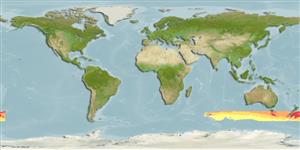Common names from other countries
>
Zeiformes (Dories) >
Oreosomatidae (Oreos) > Oreosomatinae
Etymology: Allocyttus: Greek, allos = other + Greek, kyttaros, kytos = a convex cavity; niger: niger refers to the blackish color of freshly caught specimens. It also reflects the common name "black oreo", which has been widely used in the New Zealand deepwater fishery for several years (Ref. 27159).
Environment: milieu / climate zone / depth range / distribution range
Οικολογία
Θαλασσινό(ά) βαθυπελαγικό(ς); ωκεανόδρομο(ς) (Ref. 51243); εύρος βάθους 560 - 1300 m (Ref. 6390). Deep-water; 43°S - 55°S, 65°E - 174°W (Ref. 27159)
Southwest Pacific: New Zealand and Australian waters south of 43°S, and south of Tasmania at 47°S. Also Ref. 26139.
Length at first maturity / Μέγεθος / Βάρος / Age
Maturity: Lm ?, range 36 - ? cm
Max length : 47.0 cm TL αρσενικό/απροσδιόριστο; (Ref. 6390); common length : 35.0 cm TL αρσενικό/απροσδιόριστο; (Ref. 9258); μεγ. δημοσιευμένο βάρος: 1.5 kg (Ref. 6390); μεγ. αναφερόμενη ηλικία: 100 έτη (Ref. 27140)
Found close to the sea bed in deep water. Form large shoals over rough ground near pinnacles and canyons. Juveniles are pelagic and inhabit oceanic waters. They tend to be dispersed over smooth grounds (Ref. 6390). Feed mainly on salps and benthic crustaceans (Ref. 27150). Eggs float near the sea surface and larvae also inhabit surface waters (Ref. 6390). Based on trawl catch rates, there is no evidence of vertical migration during day or night (Ref. 27150).
Displays seasonally synchronised reproduction.
James, G.D., T. Inada and I. Nakamura, 1988. Revision of the oreosomatid fishes (Family Oreosomatidae) from the southern oceans, with a description of a new species. N.Z. J. Zool. 15:291-326. (Ref. 27159)
IUCN Red List Status (Ref. 130435)
CITES (Ref. 128078)
Not Evaluated
Threat to humans
Harmless
Human uses
αλιεία: Εμπορικό(ά)
Εργαλεία
Special reports
Download XML
Διαδικτυακές πηγές
Estimates based on models
Preferred temperature (Ref.
115969): 2.1 - 6.8, mean 5.1 (based on 63 cells).
Phylogenetic diversity index (Ref.
82804): PD
50 = 0.5635 [Uniqueness, from 0.5 = low to 2.0 = high].
Bayesian length-weight: a=0.01413 (0.00715 - 0.02792), b=3.03 (2.85 - 3.21), in cm Total Length, based on LWR estimates for this species & (Sub)family-body (Ref.
93245).
Τροφικό Επίπεδο (Ref.
69278): 3.5 ±0.50 se; based on food items.
Ελαστικότητα (Ref.
120179): Πολύ χαμηλό, ελάχιστος χρόνος για διπλασιασμό πληθυσμού > 14 έτη (tmax=100; tm=27; Fec >5,000).
Fishing Vulnerability (Ref.
59153): High to very high vulnerability (69 of 100).
Climate Vulnerability (Ref.
125649): Moderate vulnerability (40 of 100).
